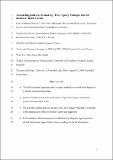Animal linguistics in the making : the Urgency Principle and titi monkeys’ alarm system
Abstract
The emergent field of animal linguistics applies linguistics tools to animal data in order to investigate potential linguistic-like properties of their communication. One of these tools is the "Urgency Principle", a pragmatic principle stating that in an alarm sequence, calls providing information about the nature or location of a threat must come before those that do not. This theoretical principle has helped understand the alarm system of putty-nosed monkeys, but whether it is relevant for animal communication systems more generally remains to be tested. Moreover, while animal communication systems can convey information via a large set of encoding mechanisms, the Urgency Principle was developed for only one encoding mechanism, call ordering. Here, we propose to extend this principle to other encoding mechanisms and empirically test this with the alarm call system of black-fronted titi monkeys (Callicebus nigrifrons). We investigated how information about the context of emission unfolded with the emission of successive calls. Specifically, we analysed how contextual parameters influenced the gradual sequential organization of the first 50 calls in the sequence, using methods borrowed from computational linguistics and random forest algorithms. We hypothesized that, if the extended Urgency Principle reflected the sequential organization of titi monkey alarm call sequences, mechanisms encoding urgent information about the predatory situation should appear before encoding mechanisms that do not. Results supported the hypothesis that mechanisms encoding for urgent information relating to a predator event consistently appeared before mechanisms encoding for less-urgent social information. Our study suggests that the extended Urgency Principle applies more generally to animal communication, demonstrating that conceptual tools from linguistics can successfully be used to study nonhuman communication systems.
Citation
Narbona Sabaté , L , Mesbahi , G , Dezecache , G , Cäsar , C , Zuberbühler , K & Berthet , M 2022 , ' Animal linguistics in the making : the Urgency Principle and titi monkeys’ alarm system ' , Ethology Ecology & Evolution , vol. 34 , no. 3 , pp. 378-394 . https://doi.org/10.1080/03949370.2021.2015452
Publication
Ethology Ecology & Evolution
Status
Peer reviewed
ISSN
0394-9370Type
Journal article
Description
This work received funding from the European Research Council under the European Union’s Seventh Framework Programme [FP7/2007–2013]/ERC grant agreement no. 283871 (PI: K. Zuberbühler), the Swiss National Science Foundation and the University of Neuchâtel, the European Research Council (ERC) under the European Union’s Seventh Framework Programme [FP/2007-2013]/ERC Grant Agreement N°324115–FRONTSEM (PI: P. Schlenker), the European Union’s Horizon 2020 research and innovation programme (grant agreement No. H2020 European Research Council 788077, Orisem, PI: P. Schlenker), from the Fyssen Foundation (post-doc grant) and from the Institut d’Études Cognitives, École Normale Supérieure − PSL Research University supported by grants ANR-10-IDEX-0001-02 and FrontCog ANR-17-EURE-0017. We acknowledge the support received from the Agence Nationale de la Recherche of the French government through the program “Investissements d’Avenir” (16-IDEX-0001 CAP 20-25); FP7 Ideas: European Research Council [283871,324115]; Fondation Fyssen; Schweizerischer Nationalfonds zur Förderung der Wissenschaftlichen Forschung; Université de Neuchâtel.Collections
Items in the St Andrews Research Repository are protected by copyright, with all rights reserved, unless otherwise indicated.

